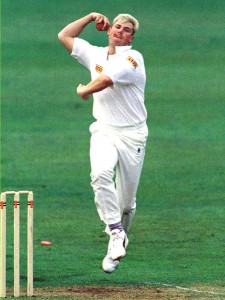
A gradual but inevitable descent into cricket-based loathing and bile.
No Such Thing As A Free Launch: Gideon Haigh’s ‘On Warne’
In case you’re lucky enough to have missed Shane Warne’s latest (or at least, the latest that we bothered to read) installment of his big ideas for taking Australian cricket forward, one of his suggestions is to make the stumps wider and taller. Ostensibly this is to increase the number of wickets either bowled or LBW, thus helping to balance the battle between bat and ball (which is a battle we’re not sure that bowlers are really losing anyway). He doesn’t say whether this would be a permanent change or only for the opposition innings, but as his proclamations are intended to benefit Australia, we can only assume it’s the latter. Either way, the harebrained idea is sadly typical of Warne’s whole muddled manifesto.
These days, Warne has become a bit of a joke. The celebrity fiancee, the embarrassment of this year’s Big Bash and his stream of rubbish on Twitter outweigh the salient insight he occasionally offers from the commentary box. This is one of the themes that Gideon Haigh explores in this book, which was published last year and which we’ve shamefully only just read. Okay, so Haigh doesn’t go so far as to call Warne a joke – the book is rightly more reverent than that – but he does at times consider Warne’s silliness (which others have described as stupidity and which to us, as distant outsiders, appears to be naivety), whether its in the context of the scandals that took place during his playing career or his post-international transition to poker-playing, hair clinic-endorsing celebrity.
This book is much much more than a standard biography that follows a linear narrative. With a player as familiar as Warne, who has spent 20 years in the public eye, a chronological description of his career would be pointless. Instead Haigh starts, with more than a little pretension, with the Art of Warne, in which he writes about his bowling with, somewhat appropriately, some of the finest prose we’re read in a cricket book. He moves on to devote chapters to Warne’s relationship with four different men and to the aforementioned scandals; what we are ultimately presented with is a series of essays that analyse Warne’s character, his traits and his cricket in magnificent detail. By structuring the book in this manner, it also enables Haigh to present himself more fully than if he were merely stating the biographical facts.
It therefore is no great surprise that when a great writer encounters a great subject, the result is a great book. And that is what this book really reinforces: despite some questionable choices and actions, Warne remains probably the greatest modern cricketer.




No Comments
Post a Comment